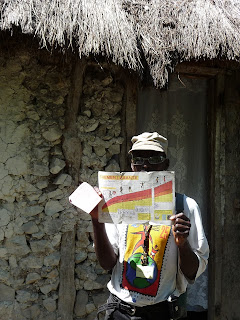 |
| The SCI team visits the home of a household with high risk factors for malnutrition |
 |
| A community health worker shows off the normal weight record of a child in a high-risk household |
Our discussions with the mothers of PD children brought out some of the steps taken by mothers to ensure that their children were well provided for.
When we complimented one mother on her child's obvious good health, and noted that surely life was difficult in the mountains, she explained "nou pa chita"; we don't sit down. Very animatedly, she told how during that week, she had bought limes from neighbors, loaded them in straw bags on her donkey, and took them down to the Verettes market to sell. She took the money which she earned from the limes, and bought toothpaste and imported foods from the Dominican Republic (which are not available in the mountains) and sold them to her neighbors. With her small profits, she bought rice, which only grows in the irrigated lowlands, for several nutritious meals for her family.
Her energy and creativity, as well as her concern for her family, combine in the design of her work week to add income to the household and to protect her children.
The strategic plan for HAS’ nutrition services include the establishment of nutrition rehabilitation services at the two mountain dispensaries, which will reduce the need for the children and mothers to spend several weeks far from home, and will provide a base for community-based education in nutrition. One of the key resources for this effort will be the mothers who have developed strategies to protect their children. These shining examples of Positive Deviance will be folded into the educational programs as local experts, to share their success stories with their neighbors.
Ian Rawson



